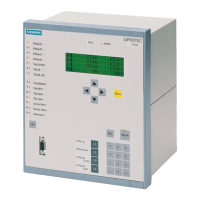'(& )( )'& &) ( &!& ")& &$(( $# Ć %&( $# #)" &&#$
2 - 5
Siemens AG ⋅ May 1998
2.3.4 Trip output/reset
The signal processing is distinguished by the followĆ
ing characteristics:
D Feeder-selective TRIP command by the bay units.
D Feeder-selective selectable overcurrent release of
the TRIP command.
D Extension of busbar TRIP signal for set time
D Current-controlled reset of TRIP signal
2.3.5 Fault recording
The digitized phase current values of all feeders and
the differential and stabilizing currents of the bus zoĆ
nes and the check zone are stored. This fault record,
starting 200 ms before the TRIP command and termiĆ
nating 100 ms after the TRIP command is initiated by
a busbar short-circuit, by binary input or by operation
from the master unit. The 7SS52 stores up to 2 fault
records.
The fault data can be read out via the serial interface
of the master unit and analysed by the communicaĆ
tion program DIGSI.
2.3.6 Binary inputs, trip outputs,
re-assignable alarm relays and LED's
The bay units are the interface link to the station.
Each bay unit has
D 4 command relays with each 2 NO contacts
D 1 command relay with 1 NO contact
D 1 alarm relay with 1 NO contact
D 1 alarm relay with 2 NO contacts (device failure,
not marshallable)
The functional allocation of the outputs can be marsĆ
halled via the keypad of each bay unit.
10 binary inputs are used for recognition of the isolaĆ
tor states. The status is indicated via LEDs.
All binary inputs and corresponding LEDs of the bay
unit are freely marshallable.
Upto2x16alarm relays and LEDs in the master unit
can be marshalled with various functions for user-
specific output and indication.
Several single alarms can form a group alarm.
Up to 7 fixed allocated binary inputs can be used to
control functions of the master unit (e.g. release fault
record, acknowledge LED).
2.3.7 Measuring and testing functions
The 7SS52 provides a variety of measuring and teĆ
sting functions to assist during commissioning and
maintenance.
D Display of the feeder currents per phase in each
bay unit and in the master unit. In addition the data
are available at the serial interface.
D Calculation of differential and stabilizing currents
phase-selective and zone-selective. Display of
these values in the master unit and for the check
zone in the bay unit. In addition the data are availaĆ
ble at the serial interface.
D Monitoring of the zone-selective and phase-selecĆ
tive differential currents with zone-selective blokĆ
king or alarm output.
D Monitoring of the differential currents in the check
zone with blocking of the busbar protection and
alarm output.
D Phase-selective trip test including control of the
feeder circuit breaker (from master unit or bay
unit).
D Removal of one bay from the busbar protection
processing via master unit or bay unit, e.g during
maintenance works ("bay out of service").
D Cyclic test of measured value aquisition, measured
value processing and trip circuit test including the
coils of the command relays.

